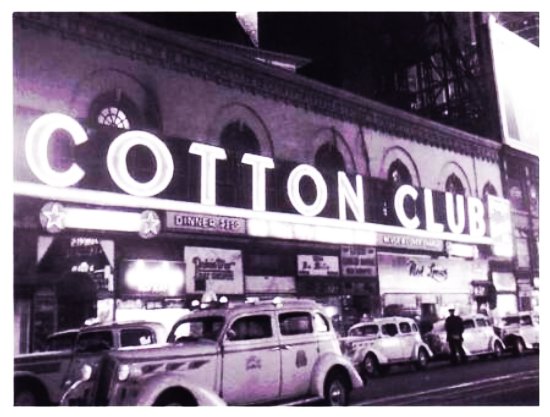The Caucasian Storms Harlem
Cotton Club by Gary Kelly
Rudolph Fisher speaks about the manner in which the Harlem Rennaisance operated. A huge dynamic of the movement was in how it was received by white America. Whites were fascinated by the culture and society that they found so seperate from themselves. They would venture into Harlem at night to get a taste of something "exotic". This was part of the reason why the movement was so succesful. It was the first time in American history where attention and admiration was given to anything distinctly African-American. This is a hallmark piece to discuss beacuse it shows the intersection between the Jazz Age and Harlem Renaissance.

pg. 111 He speaks of Harlem's nightly hot spots such as Nest's, Small's, Connie's Inn, the Cotton Club and others. These clubs emerged as a result of segregation that prevented blacks from attending other major night clubs in New York. Ironically many of these great black cabarets ended up huge white attractions and ended up catering only to white patrons because of the popularity of black culture during the era. Fisher exclaims,"There was no mistake; my discovery was real and was repeatedly confirmed. No wonder my old crowd was not to be found in any of them. The best of Harlem's black cabarets have changed their names and turned white"(111). This fascination by white patrons displaced the original clientele.This necessity for night clubs that served an African-American audience exclusively, sprang up in the first place because of a lack of places that allowed blacks to enter. Most nightclubs were open to having black talent at their venue but refused to allow African-Americans to be in the audience. Lybia is one in particular that he emphasizes as a place worth going to because it was exclusive to blacks and didn't give in to the huge numbers of whites who would come to Harlem for a piece of entertainment. Fisher makes it clear that he was frustrated with the invasion of whites into the Harlem night scene because it was almost like being at the zoo. Whites would come to observe and explore African-American culture but they up-rooted the very places that blacks would go to get away. Additionally, much of the original music and arts from these scenes, were borrowed and/or stolen from these night clubs and co-opted into white forms of music.
pg. 113 Ethel Waters' "Tryin' to Teach My Good Man Right from Wrong" and "Shake That Thing!" are mentioned by Fisher as examples of fine music and popular ones as well. He took the time to speak about Ethel Waters because she was a big name at the time but also because she was a mainstay in New York. During the 1920's, her influence and style of singing was embraced by a number of black musicians such as Fletcher Henderson and Duke Ellington. Rudolph Fisher's way of speaking about Ethel almost comes across as a type of ownership. He remembers when she was only referred to as Ethel and takes pride in the growth of her career and the expanse of her success. Ethel Waters, like many of the other artists of the time who came out of Harlem and African-American culture were able to grow up and for the first time in American history become headliners. The Harlem Renaissance was recognized as a viable source of entertainment and regard and the artists used their spotlight to the best of their advantage. This was progress and acceptance. No matter the cost of exploitation, it at least made room for future endeavors.
 pg. 115 Shuffle Along was the first major African-American musical which debuted on Broadway in 1921. The musical written by Flournoy Miller and Aubrey Lyles, was a great conmtribution to the advancement of the Harlem Renaissance. This was a historical first for African-Americans in that the play's success proved that audiences were willing to come and see African-Americans on Broadway. As an all black cast, it featured Florence Mills as the lead part. The material from this musical by today's standards would be deemed highly racialized and chalk full of stereotypically degrading images of African-Americans, however at the time this was one of the few if any distinctly black representations offered up for and by African-Americans.
pg. 115 Shuffle Along was the first major African-American musical which debuted on Broadway in 1921. The musical written by Flournoy Miller and Aubrey Lyles, was a great conmtribution to the advancement of the Harlem Renaissance. This was a historical first for African-Americans in that the play's success proved that audiences were willing to come and see African-Americans on Broadway. As an all black cast, it featured Florence Mills as the lead part. The material from this musical by today's standards would be deemed highly racialized and chalk full of stereotypically degrading images of African-Americans, however at the time this was one of the few if any distinctly black representations offered up for and by African-Americans.
Navigation
